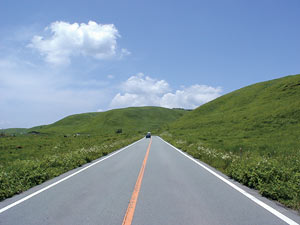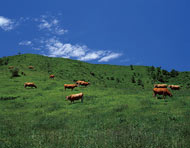16.Milk Road Grassland Geosite
Vast grasslands cover the north outer rim
The Milk Road winds through the gorgeous grassland scenery of the central cone group and the outer slopes of the caldera rim. Tracing the outer rim's ridge for 45 km, the road includes portions of prefectural Routes 339, 12, and 45.
The grasslands of the caldera's outer rim grow thick with pampas grass and dwarf bamboo grass, which thrive in the landscape created by pyroclastic flow and volcanic ash. In fall, the hills turn a beautiful golden hue. Similar scenery unfolds over the slopes of the central cone group, seeming to magnify the breathtaking scale of the landscape. The herds of black and brown cows grazing the meadows make for a perfect photo opportunity
Most landscapes in Japan evolve towards forest if the land is left undisturbed.The reason these grasslands have remained open for so many centuries is twofold. On the one hand, repeated volcanic eruptions and ash deposits have prevented trees from growing. But human management, which includes grazing, grass harvesting, and controlled burning, has also played a large role. The grasslands are a historical product of coexistence between humans and nature that has lasted for over a thousand years.
Although the role of volcanic eruptions is significant, controlled burns are believed to have a particularly beneficial impact on the grasslands. Burning suppresses the growth of large plants, allows meadow plants and animals to thrive, and helps protect both water resources and soil. Ultimately it also contributes to the local economy by enabling the livestock industry to prosper and, more recently, attracting tourists.

Grasslands
If any one landscape symbolizes Aso, it is the grasslands that seem to extend endlessly into the distance. This semi-natural environment has its origins in the effective use of volcanic soils by local farmers who learned to coexist with the volcano over many centuries. The attractive open vistas are the result of continuous grazing, burning and grass harvesting by these communities.
